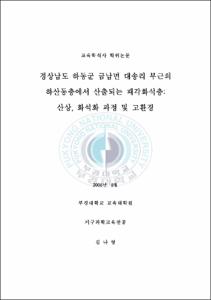경상남도 하동군 금남면 대송리 부근의 하산동층에서 산출되는 패각화석층
- Alternative Title
- Shell deposits in the Lower Cretaceous Hasandong Formation from the Daesong-ri, Geumnam-myeon, Hadong-county, Gyeongsangnamdo : Occurrence, Taphonomy and Paleoenvirnments.
- Abstract
- The Hasandong Formation, the middle part of the Sindong Group of the Gyeongsang Supergroup, consists of mostly alternating channel sandstones and interchannel fine deposits. In these fluvial deposits, lacustrine deposits (a few tens of meters thick) are intercalated at some localities. Calcic and vertic paleosols are common in the floodplain deposits composed of mostly purple to red or greenish grey beds. In study area lacustrine deposits without red beds occur between fluvial deposits including red beds. In the lacustrine deposits, gastropod and pelecypod shells are intermittently concentrated, and some vertebrate bone and carbonized wood fragments are contained.
These lacustrine deposits are classified into 7 sedimentary facies and their depositional environments are interpreted as follows: (1) Dunoid medium sandstone facies- sandflat; (2) Graded fine sandstone facies- sandflat; (3) Planar- to cross-laminated fine sandstone facies- sandflat; (4) Disrupted silty mudstone facies- mudflat; (5) Calcareous sandy to silty mudstone facies- mudflat; (6) Interlaminated to very thinly interbedded fine sandstone to siltstone and mudstone facies- sandflat to mudflat; (7) Calcareous shaley silty mudstone- mudflat to shallow lake.
The shell deposits in this study area are divided into three types based on lithology, mode of shell occurrence and associated fossils. Type 1 shell deposits occur in interlaminated to very thinly interbedded fine sandstone to siltstone and mudstone facies. In Type 1 shell deposits, mostly gastropod shells and some pelecypod shells occur in fine sandstone to siltstone with sharply erosive lower contacts as beds or lenses in thickness of 0.5 to 10 cm . The gastropod shells are Brotiopsis wakinoensis. They occur as whole ones, breakage ones, and some fragments. These concentrations are composed of moderately to highly abraded shells aligned with bedding without bioerosion. This indicates that the fauna is thanatocoenosis due to subaerial exposure and drying, and then shells were transported from the inhabitation (parautochthonous) when sheet flooding occurred during wet period.
Type 2 shell deposits occur in the graded fine sandstone with erosive lower bedding contacts, and gastropod and pelecypod shells occur together forming lenses in thickness of 5 to 10 cm. The gastropod shells are Brotiopsis wakinoensis in mostly breakage ones, fragments and some whole ones. Pelecypod shells are articulate or disarticulate, and randomly oriented. They occur as highly abraded shells without bioerosion. This indicates that shells were transported from the inhabitation(parautochthonous) when sheet flooding occurred during wet period. Hydraulic energy for type 2 shell concentration is deemed to have been higher than that of Type 1 shell deposits.
Type 3 shell deposits occur in the calcareous shaley silty mudstone without sharp erosional bases, and contain gastropd shells. The gastropod shells occur as beds or patches and totally about 40 layers of the shell concentrations in thickness of 0.5 to 2 cm are observed in the 3 m thick sequence. The shells are exclusively Brotiopsis wakinoensis in whole ones, breakage ones and some fragments. Some shells show preferred orientations and minimal damage by bioerosion and abrasion. This indicates that shells were preserved in life position (autochthonous).
The study area might have been mudflat and sandflat which was located in floodplain. The floodplain lake is deemed to have been shallow and temporary one that was affected by sheet flooding. Gastropods and pelecypods inhabited floodplain lake. The taphonpmic types of the shell deposits might have been influenced by the paleoclimatic condition. The paleoclimate during the taphonomic processes is interpreted that wetting and drying periods were alternated under generally warm and arid climate.
- Issued Date
- 2008
- Awarded Date
- 2008. 8
- Type
- Dissertation
- Publisher
- 부경대학교 교육대학원
- Alternative Author(s)
- Kim, Na-young
- Affiliation
- 부경대학교 교육대학원
- Department
- 교육대학원 지구과학교육전공
- Advisor
- 백인성
- Table Of Contents
- 1. 서론 = 1
2. 층서 및 지질개관 = 3
3. 퇴적상 및 퇴적환경 = 9
3.1. 사구상 중립 사암(Dunoid medium sandstone) = 11
3.2. 점이적인 세립 사암(Graded fine sandstone) = 14
3.3. 판상 내지 사엽층리가 발달된 세립 사암(Planar- to cross-laminated fine sandstone) = 16
3.4. 교란된 실트질 이암(Disrupted silty mudstone) = 18
3.5. 석회질의 사질 내지 실트질 이암(Calcareous sandy to silty mudstone) = 21
3.6. 엽층 내지 매우 얇은 층으로 발달한 세립 사암 내지 실트스톤과 이암의 호층(Interlaminated to very thinly interbedded fine sandstone to siltstone and mudstone) = 23
3.7. 석회질의 셰일상 실트질 이암(Calcareous shaley silty mudstone) = 26
3.8. 퇴적상의 수직적인 변화양상 = 29
4. 패각화석층의 유형 및 산상 = 32
4.1. Type 1 = 33
4.2. Type 2 = 35
4.3. Type 3 = 37
4.4. 참고지역 하산동층 내의 패각화석층 = 42
4.1.1. 경상남도 하동군 진교면 양포리의 패각화석층 = 42
4.1.2. 경상남도 사천시 서포면 내구리의 패각화석층 = 45
5. 화석화과정(Taphonomy) = 47
5.1. Brotiopsis 속(屬)의 고생물학적 특성과 생지리학적(biogeography) 특성 = 48
5.2. 패각화석층의 화석화 과정 = 49
5.2.1. 퇴적학적 요인 (Sedimentological concentrations) = 51
5.2.2. 생물학적 요인 (Biologenic concentrations) = 55
6. 고환경 해석 = 57
7. 토의 및 결론 = 60
참고문헌 = 62
요약 = 68
감사의 글 = 71
- Degree
- Master
- Files in This Item:
-
-
Download
 경상남도 하동군 금남면 대송리 부근의 하산동층에서 산출되는 패각화석층.pdf
기타 데이터 / 22.54 MB / Adobe PDF
경상남도 하동군 금남면 대송리 부근의 하산동층에서 산출되는 패각화석층.pdf
기타 데이터 / 22.54 MB / Adobe PDF
-
Items in Repository are protected by copyright, with all rights reserved, unless otherwise indicated.